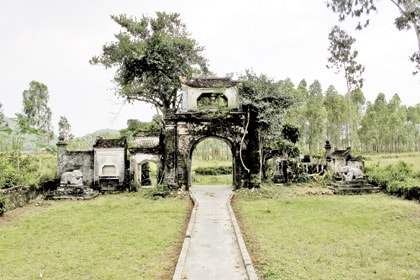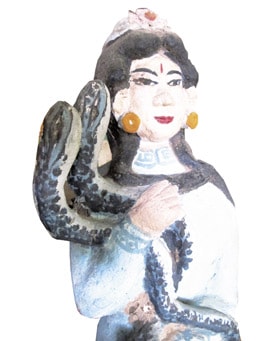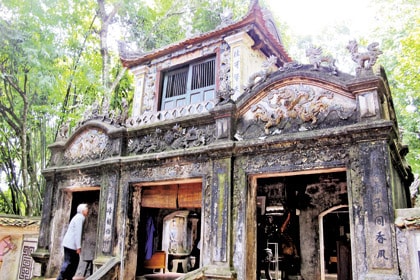The mysterious story of the snake god in Yen Thanh
The north of Yen Thanh district is a semi-mountainous area with extremely beautiful, dense, and charming river and mountain shapes. Many mountains, hills, lakes, dams, and fields here... are associated with legends and anecdotes. Among them, the legend of the snake god is one of the stories with many mysterious colors, and strangely enough, until now, people in the area still tell it with the belief that this is a true story that happened in ancient times... The legend of "Mr. Cut off the lake, Mr. Good, Mr. Evil"
(Baonghean) -The north of Yen Thanh district is a semi-mountainous area with extremely beautiful, dense and charming river and mountain shapes. Many mountains, hills, lakes, dams, and fields here are associated with legends and anecdotes. Among them, the legend of the snake god is one of the stories with many mysterious colors, and strangely enough, until now, people in the area still tell it with the belief that this is a true story that happened in ancient times...
The Legend of "The Mute Man, the Good Man, the Evil Man"

Three gates of Canh Ha temple
In the northern communes of Yen Thanh district, there is a legend about a snake god with the popular name of "Mr. Cut Bau Canh, Mr. Good Bau Ac". From the beginning to the end of the legend, each character and each detail is proven by place names, temples, traces... forming a system of relics, famous places, and place names stretching across the communes: Phuc Thanh, Lang Thanh, Duc Thanh, Ma Thanh (Yen Thanh district). According to the people, a long time ago, in Dieu Oc village, Gia Lac commune, Quan Trieu commune (now Dieu Oc village, Phuc Thanh commune), there was a pond about 20 acres wide, people also called Bau Ac, some ancient books called Dam O. In the past, when visiting Bau Ac, talented scholars said that this pond had many beautiful lotus flowers, no less than the Thai Dich pond in the capital. In the village near the pond, there was a virtuous farmer couple, but they were old and could not have children. One day, the wife went down to bathe in the pond and suddenly felt a strange aura on her body, as if she had a connection with the gods. She had a dream as if she saw a dragon covering her. When she returned home, she saw a dragon clinging to her body. Later, the wife became pregnant and gave birth to two eggs, which hatched into two snakes. The farmer and his wife loved their two special children very much. The two snakes grew up and were very smart, following their parents everywhere, always accompanying them. One day, while hoeing, the father accidentally cut off the tail of a snake. With its tail cut off, the snake was surprised, angry, puffed up its hood, and stood upright, looking straight at the father. The father, both loving and afraid, knelt down and kept saying: “Phu bai tu, phu bai tu” (father bows to son). The snake was in pain and ran away. The mound where the father knelt down and bowed to his son was later called “Bai Tu Phong” hill.
The snake went east, passed Quy Trach lagoon, and when it reached the middle of the field, it writhed and struggled, blood dripping red all over the field. Where the snake wriggled, it formed a pond, which the locals called Bau Canh. Until now, Bau Canh's shape is still intact, winding and zigzagging in the middle of the large field of Duc Thanh commune, bordering Ma Thanh commune. When exhausted, the snake crawled into the forest, went to the upstream stream and died there. That place was later called Khe Than. Loving their child, the farmer and his wife followed the trail to find him. After wading to the edge of the forest, the mother lay down exhausted, that forest was later called Ngan Nha Ba. The father struggled to continue, near Khe Than, also lay down exhausted, that forest was later called Ngan Nha Ong.

Statue of a mother holding two snakes at Canh Ha temple
The good snake stayed in Bau Ac, sad because its brother and parents had left it, the good snake crawled to the bank of Bau Ac and died there. Legend has it that after death, the snake brothers all turned into lucky gods. On hot summer nights, people lying in their houses heard the sound of leaves shaking strongly, clearly heard the sound of moving like the wind blowing, waking up in the morning to see trees and grass falling along the path stretching from the forest down to the lake. People thought that was a sign of the snake god coming to cool off. Or when passing through dense forests, hearing the sound of wind blowing was when the god appeared. During times of great drought, with Lao wind (Lao storm), the fields were dry and cracked, going to Bau Canh and Bau Ac to pray, immediately there would be favorable rain and wind. During times of great floods, people went to Bau Canh and Bau Ac to pray, which would reduce and avoid great disasters caused by natural disasters. Therefore, the people in the area worshiped the snake god as “Mr.” and built a temple to worship the crippled man in Canh lake, and a temple to worship the good man in Ac lake. From then on, there was a folk story “Mr. crippled in Canh lake, good man in Ac lake.”
Stories told at two sacred temples
The temple to worship the amputee was built next to Canh lake, where the amputee painfully bled a lot before going to the forest to become a god, called Canh Ha temple. The temple is located in the middle of the field of Tho Canh village (Chau Canh), built by the people on a rather large scale, with a T-shaped architecture, four pillars, three gates, next to the three gates are two elephants made of monolithic stone with very delicate carvings. In Canh Ha temple, there is also a small shrine with a statue of a mother holding two snakes. Legend has it that in the temple, on days of changing weather and seasons, people in the area still see the dragon spirit appearing. During droughts, crop failures and famines, people come to the temple to pray for favorable weather and wind, all of which are very effective. The temple is located in the middle of a low-lying field and has been affected by many natural disasters, so it has been largely forgotten. The people in the area have restored and embellished it many times, but to this day, many ancient vestiges such as the three-gate gate, a pair of stone elephants, and a shrine to the snake god are still preserved. The main gate of Canh Ha temple has a strangely shaped banyan tree, its trunk and roots are like countless large and small snakes, short and long, embracing and covering the entire main gate, at the same time embracing and preserving the ancient architectural features left from long ago. Considering it a strange thing, right at the main gate, people also set up an altar to burn incense and worship.
Behind the gate of Canh Ha temple, there is a pair of stone elephants on both sides. According to the locals, the stone elephants were carved from stone taken from the Ngan Nha Ong and Ngan Nha Ba areas. In the 90s of the last century, Duc Thanh commune built a hall in Ke Sang village. To decorate the new hall, the commune sent people to move two elephants to stand in front of the hall gate. Not long after that, two incumbent officials of the commune suddenly died. The commune immediately sent people to move the pair of stone elephants back to their original positions, and everything returned to normal. The above incident may have been a coincidence, but it multiplied fear, sowing in the minds of the people here an obsession about the sacredness of the gods.
Next to Bau Ac, where Mr. Lanh died, there was a termite mound. People surrounded the ground and built a temple, worshiping Mr. Lanh as the Thanh Hoang of Dieu Oc village, so it was also called Hoang Temple. This temple initially worshiped only Mr. Lanh, later worshiped many gods, in which the main worship was still the snake god (Mr. Lanh) and Sat Hai Dai Vuong Hoang Ta Thon, so it was also called Duc Hoang Temple. Hoang Ta Thon was from Ke Van (Dien Van commune, Dien Chau district). He had a special talent for swimming and moving underwater as easily as on land. During the Tran Dynasty, when the Yuan-Mongol army invaded our country, Hoang Ta Thon was granted a seal and commanded tens of thousands of navy soldiers and ships. With the tactic of diving underwater to drill enemy ships, he contributed greatly to defeating the Yuan-Mongol army, the most famous of which was the great battle on Bach Dang river in 1288. In recognition of Hoang Ta Thon's achievements, King Tran Nhan Tong conferred on him the title "Sat Hai Dai Tuong Quan". When he died, the Tran Dynasty built a temple in Ke Van and honored him as “Sat Hai Chang Lai Dai Tuong Quan, Thien Bong Nguyen Soai Chi Than”. At the same time, people in Thanh Hoa and Nghe An also built many temples to worship him as a hero who protected the country and saved the people.

Duc Hoang Temple
During the Nguyen Dynasty, there was a Confucian scholar who was very good at medicine, philosophy, and fortune-telling. For some reason, he went into hiding and came to Duc Hoang Temple to be the temple keeper and left behind many medicinal recipes for diseases according to bamboo cards. Nowadays, there are still bamboo cards classified into tubes, each type of bamboo card corresponds to each traditional medicine, each tube of card is for each age, gender, symptom or diseased body part... Nowadays, the practice of shaking cards to ask for medicine, shaking cards to ask for good or bad luck still exists as a way to preserve a traditional cultural feature in spring and on holidays.
Duc Hoang Temple has been ranked as a National Historical Relic. Duc Hoang Temple Festival is held from January 30 to February 1 of the lunar calendar with many religious activities and folk games attracting the participation of many tourists and children of the rice fields.
The story of “Mr. Cut Bau Canh, Mr. Good, Mr. Evil” is one of the vivid proofs showing that since ancient times, snakes have been a sacred animal with an important position in the spiritual life and beliefs of Vietnamese people in Nghe An. The belief in worshipping the snake god has partly reflected the close connection between each individual and their origin, with the wet rice farming culture that is closely dependent on nature, relying on nature. Therefore, the story of “Mr. Cut Bau Canh, Mr. Good, Mr. Evil” also contains profound philosophies of life about human attitudes and behaviors towards nature, and human behaviors towards the harsh laws of nature!
Article and photos: Ngo Kien






